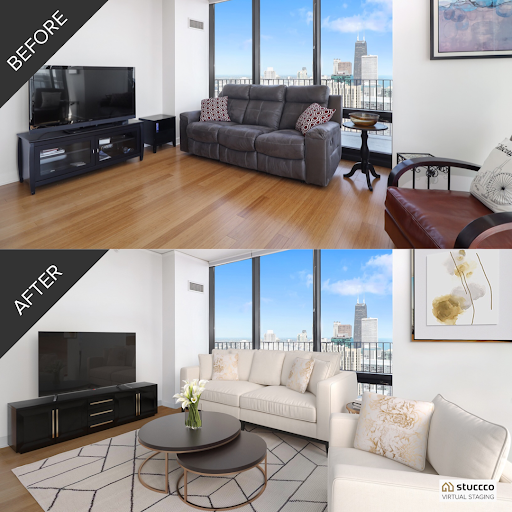Virtual Staging Cost: Understanding Pricing and ROI
Virtual staging is a relatively new method of selling a home for the most amount of money. The most asked question that real estate professionals and homeowners have is always: how much does virtual staging cost?
This article will cover the cost of virtual home staging with the top virtual staging companies, as well as the things you need to know to calculate actual pricing and its overall value. If you're looking for the cheapest virtual staging service, you can see which company to use below. If you want the maximum ROI (return on investment) out of virtual staging, read on.
Here's what we'll cover:
- How are virtual staging costs calculated?
- Traditional home staging vs. virtual staging costs
- The cost of virtual staging
- Who pays for virtual staging?
- Is virtual staging worth the cost?
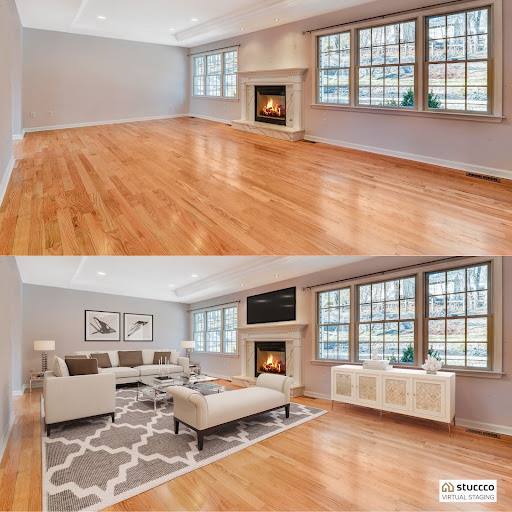
If you are not already familiar with what virtual staging is, start by reading our full guide that covers common concerns about virtual staging and a number of examples for its use.
How Are Virtual Staging Costs Calculated?
To understand virtual staging costs and value, you first need to see how different virtual staging companies and services work. Although all virtual staging companies use software, each company uses it differently, with different levels of image quality, different pricing structures, and very different results when it comes to selling houses.
The prices of virtual staging can vary widely (from $19 - 79 per photo), but it only takes a few considerations to get the best results and maximize your ROI.
The value of virtual staging essentially comes down to each staging company's process, services, inventory, and staging expertise.
Virtual Staging Process
In general, the virtual staging process looks like this:
- Photograph your listing
- Choose how many photos you want to be staged
- Choose which virtual staging services you need for each photo
- Choose how you want your listing photos staged (overall design style, specific furniture sets, or leaving it up to a designer)
- Submit order
- Receive staged photos within the specified turnaround time
It should be a simple process. In fact, the ease and simplicity of virtual staging is one of its primary benefits. While traditional home staging requires extensive planning, virtual staging should easily become part of your listing marketing plan without additional stress.
Unfortunately, this is not always the case. Some virtual staging companies have a complicated pricing structure, and you won't actually know for sure what your final price will be until after you've loaded all of your photos. Read more about the problems with this method in our Styldod review.
Other virtual staging companies require customers to select each piece of furniture and decor for each room. This means that you need to be the home staging expert--which is not a natural position for most real estate agents or homeowners. Even if you want to be in charge of every element of the design, it will require extensive time to plan and decide on your design. For more details, read the VHT Studios Review.
Finally, there are other virtual staging companies that do not specify a turnaround time at all. You could wait weeks to get your virtually staged photos back, which would likely delay your real estate listing and massively decrease the value of staging at all. It's clear why this is a massive problem, but read more details about it in the full Padstyler review.
When the process of virtual staging is a major hassle, it negatively impacts the value of virtual staging as an investment in your real estate marketing plan.
Here are a few ways Stuccco makes it easy to place an order and maximize your virtual staging ROI:
- Free guide and checklist to take great photos for virtual staging
- Step-by-step tutorial to place a virtual staging order
- Clear and complete pricing guide for all virtual staging services
- Easily accessible customer service available 24/7 via live chat and email, and business hours via phone
Virtual Staging Services
"Virtual staging" is typically used to reference adding digital furniture and decor to photos of vacant homes.
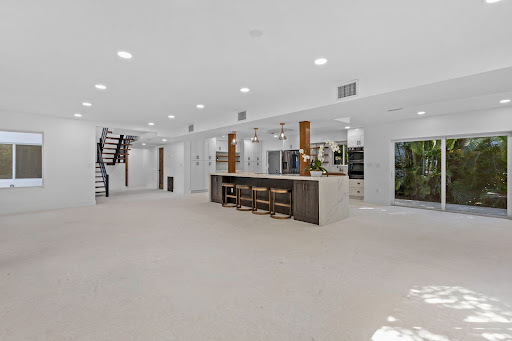
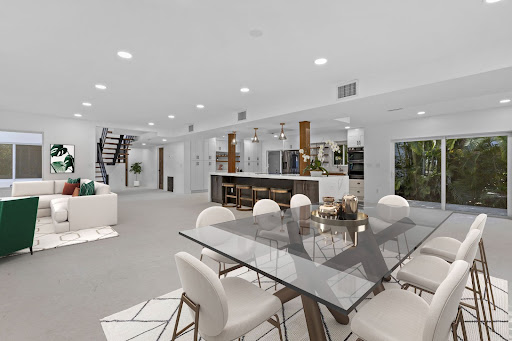
Stuccco virtual staging example
However, "virtual staging" is really an umbrella term for a range of services that utilize virtual staging software in different ways. It can include removing furniture from a photo or making more extensive changes that more accurately fit the title of "virtual renovation."
Virtual staging services can include:
- Adding furniture and decor to an empty room
- Removing items and furniture AND adding furniture and decor (also called furniture replacement)
- Change interior wall, trim, or cabinet color
- Change flooring
- Change ceiling
- Change exterior wall, trim, or door color
- Change landscaping
- Day to dusk
- Photo enhancement
A few virtual staging companies also offer floor plans. Although this isn't a type of virtual staging, it is a closely related listing marketing tool.
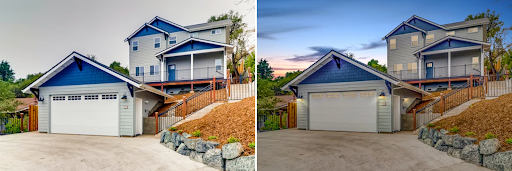
It's important to look at the cost of each virtual staging service. Sometimes the advertised price is not actually the price of the service you need. For example, staging photos of a home that is already furnished will usually require an additional fee to remove or replace furniture.
In addition, when you want to market a fixer upper or a property that is still under construction, you can use virtual staging to help potential home buyers see the final result before it exists. However, this will require different services, like changing flooring and wall colors, which are important fees to take into account.
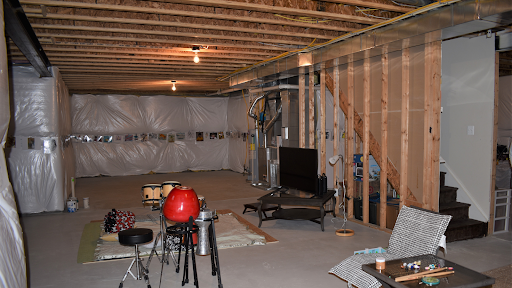
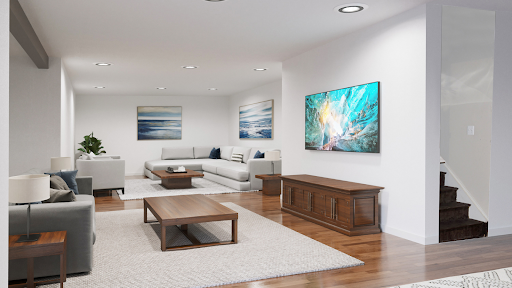
Most of our real estate customers do not place the same exact order for each listing. You may need five photos staged for one listing, and seven staged for another. One listing may only need virtual staging, and another listing may need furniture replacement and photo enhancement.
When you are calculating the cost and value of virtual staging, consider the available services and prices of each.
Make sure you also understand the legalities and ethics of virtual staging in our guide: Is virtual staging legal?
Virtual Staging Inventory
In the case of virtual staging, "inventory" doesn't mean the same thing it means for retail stores or physical home stagers. Since all furniture and decor is digital, it's impossible to run out of stock.
However, the origin of virtual staging "inventory" matters. For example, Stuccco is the only virtual staging company that uses pieces that are actually sold in retail stores. Many furniture pieces are to-scale in the room, which is more appealing visually and helps viewers understand the size and spacing of the overall room.
On the other hand, other virtual staging companies use only digital renderings of furniture in their staged photos. That means these pieces are not based on physical products, but are created completely digitally.
While this is not necessarily a bad thing in itself, but it can result in less accuracy and more unrealistic-looking pieces and designs.
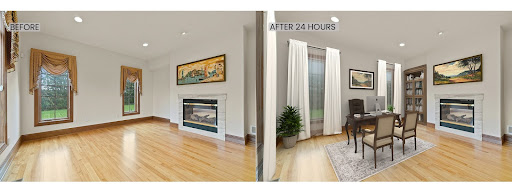
Low-quality virtual staging example from Styldod
Plus, using pieces from a physical store actually makes it possible for buyers to recreate the space in real life. Stuccco is the only company to offer both virtual staging and online interior design.
Virtual Staging Design Expertise
Arguably the most important factor in the ROI of virtual staging is the design expertise.
Home staging is not about simply making a room look pretty. There are millions of beautiful stock photos and magazine photos online that wouldn't actually make good staging photos.
The purpose of home staging is to sell a home for more money.
To do that, professional stagers have a specific set of expertise that helps them strategically add furniture and decor that highlights the overall space. It shouldn't highlight a piece of furniture or decor--it should make the space appeal more to buyers.
This is why cheap virtual staging often fails to do its job. Of course, it is possible to digitally add furniture to rooms using online programs. However, that method will not be as effective as having a professional designer using professional software.
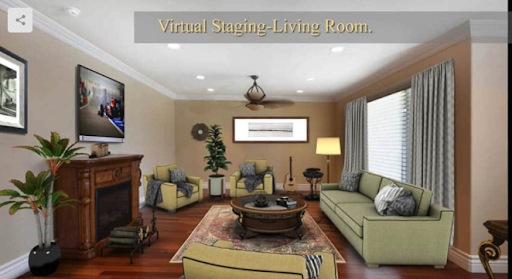
Every Stuccco virtual stager is a professional designer who knows the ins and outs of real estate listing marketing. Many virtual staging companies only hire people who can learn the software--Stuccco hires people who can use the software to sell the property for more money.
Traditional Staging vs. Virtual Staging Costs
The cost of traditional home staging is highly dependent on the local real estate market and the property. For instance, staging a home in San Francisco will cost much more than staging a similar home in Cleveland.
However, the cost of virtual staging will be a fraction of the cost of traditional staging across the country.
You can safely assume that you'll pay about 1% of the home's sale price to have it virtually staged. For many real estate agents throughout the US, this is a major problem.
A home that sells for $200,000 will cost approximately $2,000 to stage--which could be more than half of the overall commission. Instead, you could easily pay under $200 for virtual staging.
And with the right staging company, that $200 can sell the property for just as much money. Smaller expense, massive ROI.
This is why virtual home staging is growing so quickly as an alternative to traditional staging. Read more details about how traditional staging compares to virtual home staging.
The Cost of Virtual Staging
Time to look at the numbers! As discussed above, virtual staging is typically priced per photo and per service. "Virtual staging" typically refers to the process of adding furniture to a vacant room, but there are many other common virtual home staging services. These services incur a different or additional fee.
Some virtual staging companies also offer discounts on photos when you order multiple photos at the same time. For the sake of simplicity, this chart will show the price of virtual staging one photo without any bulk discounts or membership discounts.
Here are the virtual staging costs for seven of the most popular and well-known virtual staging companies:
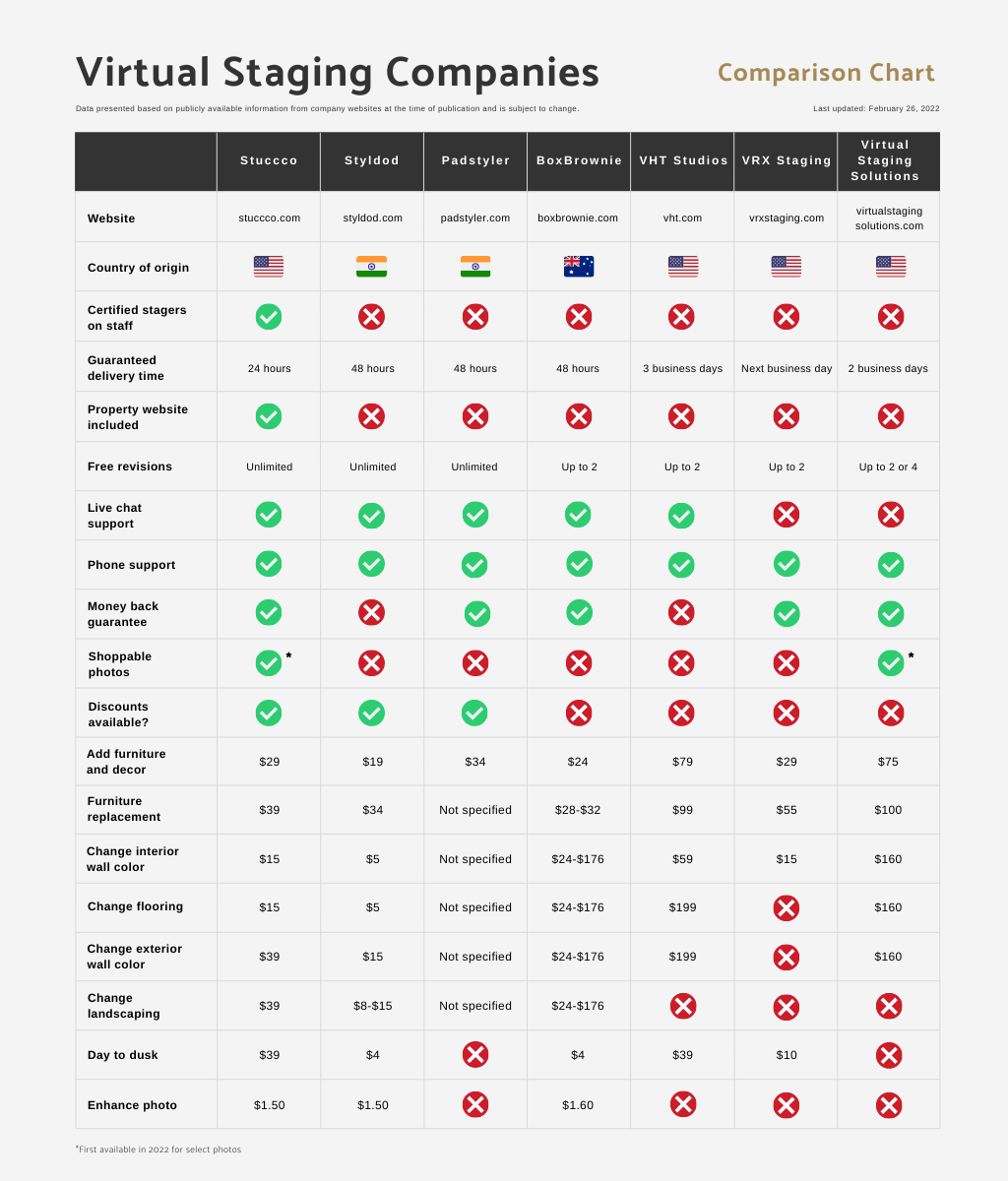
Based on this comparison, the cost of virtual staging ranges from $19-75 per photo, with a median price of $29 per photo. Additional virtual home staging services can cost as little as $4-15, and virtual renovation services cost between $15-199 per image.
Our average virtual home staging order has 6 photos and costs $204. Most staging companies recommend getting 4-6 property photos staged.
For more details about how virtual staging impacts the real estate industry, read home staging statistics.
Who Pays for Virtual Staging?
Many real estate agents wonder who's really responsible for staging a home, so let's discuss it.
There is no real estate rulebook that states exactly who pays for home staging. Some real estate brokerages pay for the staging of each listing, and some real estate agents pay for the service out of pocket.
Another way some real estate agents avoid paying for the staging by presenting it to their clients as an option to sell their home. By presenting this alongside basic home improvements (like changing light switches or repainting baseboards), homeowners choose whether or not they want to pay for home staging.
If traditional or physical home staging was the only option, this would be a great solution for listings. Traditional home staging is extremely expensive, even for affordable homes, so it's a large burden to place on any party
However, the existence of virtual home staging simplifies this problem. Instead of spending $5-10,000, home staging can cost less than $100.
Because of this, virtual home staging can be considered a business expense for real estate agents. Offering virtual home staging to your clients will elevate your level of service--and put more money back in your pocket.
Is Virtual Staging Worth the Cost?
To answer this question, let's look at a few statistics.
Assuming that virtual home staging is being paid for by the real estate agent, let's compare the cost of virtual staging to the agent's commission.
The average real estate commission is 4-6% of the home's sale price, which is split between real estate agencies. Therefore, the listing agent will receive between 2-3% of the home's sale price.
According to The Ascent, the average United States home in 2021 was worth $374,900. That would put the average agent's commission at $7,498 - $11,247.
With an average virtual staging order of $204, the cost of virtual staging is only 1.8-2.7% of the commission price.
In addition, Forbes says that staged homes sell for 87% faster and 17% more. Increasing the average home's sale price by 17% would increase an agent's commission check by $1,200.
Of course, your listings may cost significantly more or less than the average price. However, when you choose a virtual staging company with a clear and simple process, an extensive and realistic inventory, and professional staging expertise, it's clear that the ROI of virtual staging is undeniable.
Plus, take advantage of our satisfaction guarantee to place your first virtual staging order risk-free.
